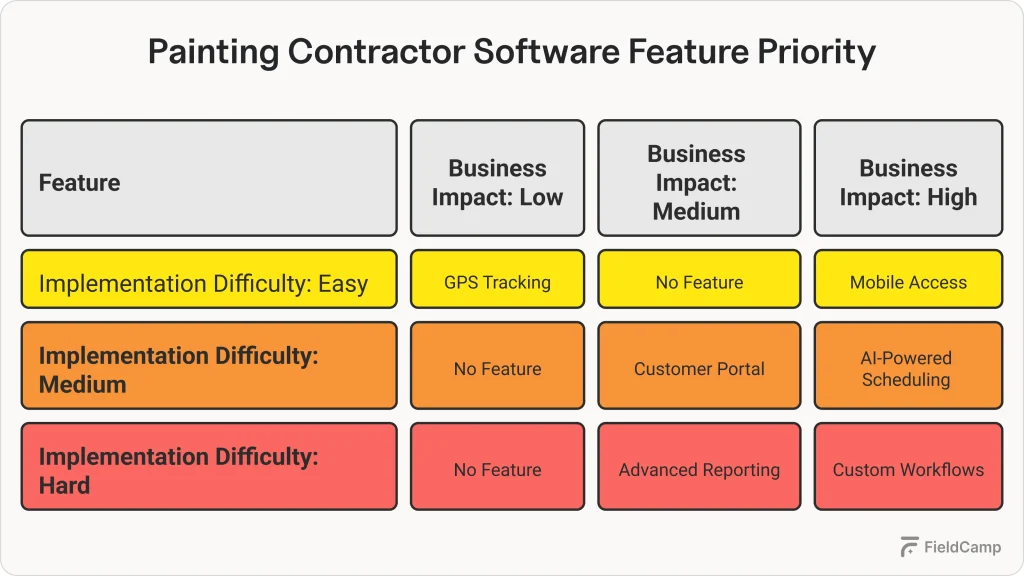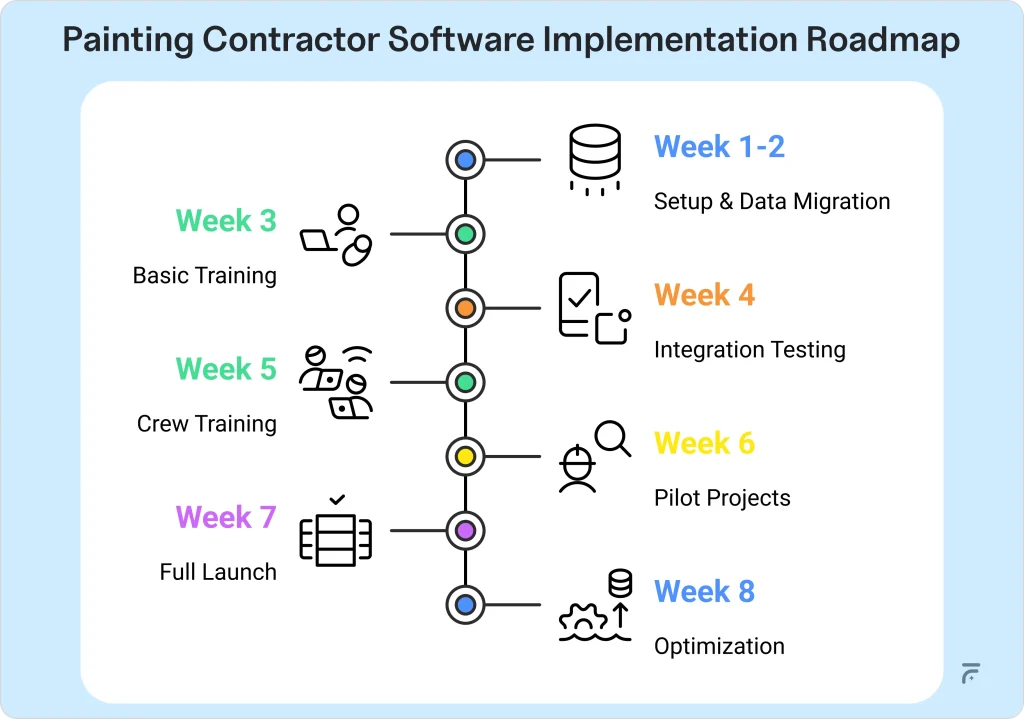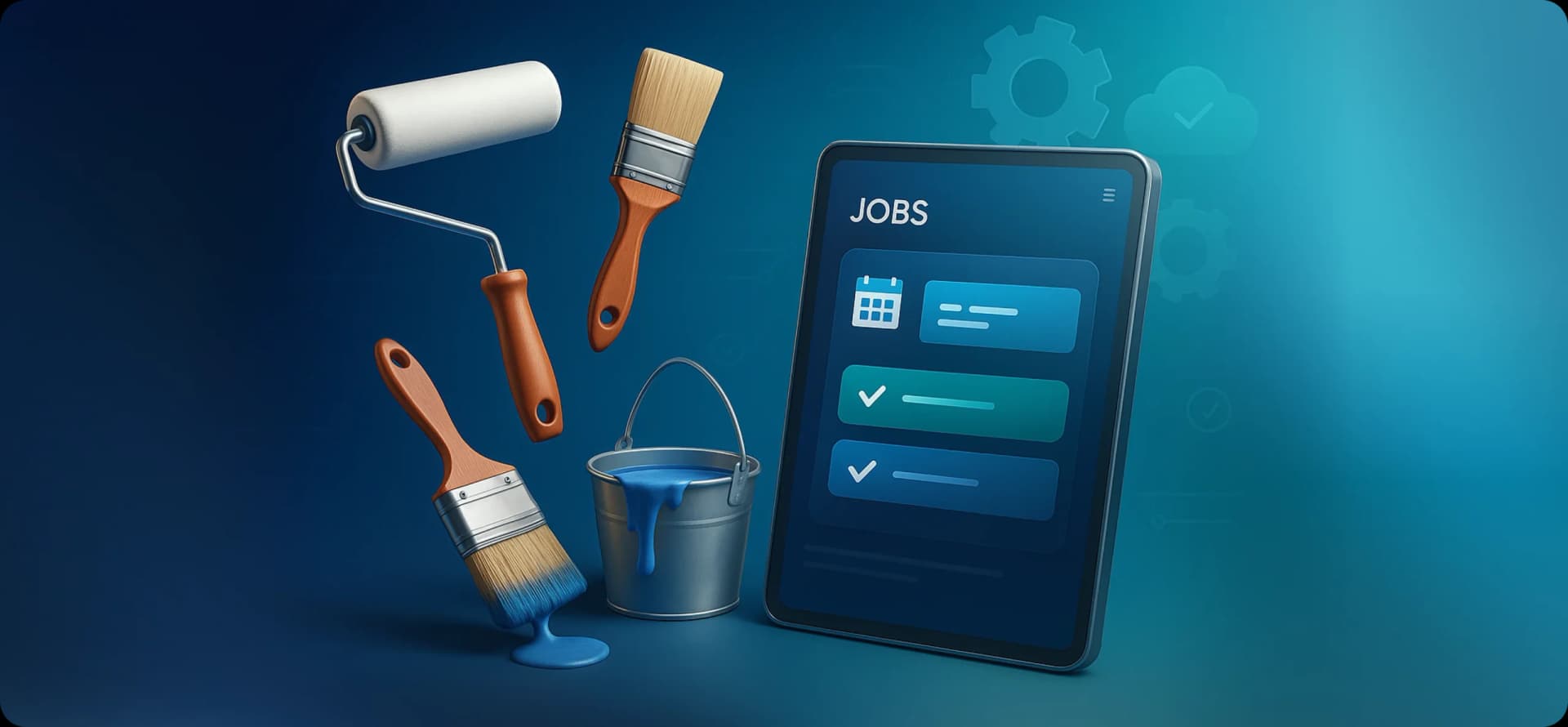Choosing the wrong software can cost your painting business thousands in lost productivity and frustrated crews. You’re juggling estimates, scheduling, inventory, and customer communications—all while trying to grow your business.
Sound familiar?
The good news is that the right software can transform these daily headaches into streamlined operations.
Modern painting contractor software solutions, like those found at FieldCamp’s painting contractor platform, now offer AI-powered features that can automate scheduling, optimize crew assignments, and even predict project timelines.
This buying guide will walk you through everything you need to make the right choice.
We’ll cover needs assessment, essential features, budget considerations, and vendor evaluation, so you can select software that grows with your business.
Ready to simplify your software selection process? Let’s dive in.
Or, if you wish to know it visually, check out our video below that sums up everything.
Assess Your Business Needs
Before you get dazzled by flashy features, start by understanding what your business needs. This foundation will save you from expensive mistakes and buyer’s remorse.
Business Size and Crew Requirements
Your business size directly impacts which software features matter most. Here’s what to consider:
Small Operations (1-5 crews):
- Simple scheduling and basic job tracking
- Mobile-friendly interface for field use
- Affordable monthly pricing
- Easy setup with minimal training
Medium Businesses (6-15 crews):
- Advanced scheduling with crew optimization
- Customer communication automation
- Inventory management capabilities
- Integration with accounting software
Large Operations (15+ crews):
- Enterprise-level reporting and analytics
- Multi-location management
- Advanced user permissions
- Scalable pricing structures
Not sure if software is even the right fit for your type of painting business? Here’s a guide on who should use painting contractor software.
Service Types (Residential vs. Commercial)
Different service types require different software capabilities:
| Residential Focus | Commercial Focus |
| Quick estimate generation | Complex project management |
| Homeowner communication tools | Multi-stakeholder coordination |
| Simple invoicing | Progress billing capabilities |
| Before/after photo features | Compliance tracking |
Current Challenges
Identify your biggest pain points to prioritize features:
- Scheduling conflicts → Look for drag-and-drop scheduling
- Lost estimates → Prioritize CRM and follow-up automation
- Inventory shortages → Focus on material tracking features
- Communication gaps → Emphasize customer portal capabilities
- Cash flow issues → Highlight invoicing and payment processing
If you’re specifically looking to save time and reduce manual work, here’s how workflow automation for painting contractors can transform your daily operations.
Growth Goals and Scalability Needs
Plan for where you want to be in 2-3 years:
- Estimate your projected crew growth
- Consider geographic expansion plans
- Evaluate potential service line additions
- Plan for increased project complexity
Essential Features to Look For
When evaluating options, these features to consider should top your buying guide checklist. Don’t get overwhelmed; focus on what directly impacts your daily operations.
Core Functionality Requirements
Every painting contractor software should include these must-have painting contractor tools:
- Project management with timeline tracking
- Customer relationship management (CRM)
- Estimate and proposal creation
- Scheduling and dispatch capabilities
- Basic invoicing and payments
- File management system
- Time tracking for crews
- Mobile app access
Pro tip: If a platform doesn’t nail these basics, move on regardless of fancy add-ons.
For a deeper dive into what goes on behind the scenes, here’s exactly how painting contractor software works.
Industry-Specific Painting Features
Look for tools designed specifically for painting contractors:
- Color matching and specification tools
- Surface preparation checklists
- Weather-dependent scheduling alerts
- Material calculation formulas
- Before/during/after photo workflows
- Paint inventory tracking with brand preferences
- Warranty and touch-up scheduling
- Lead paint and safety compliance tracking
These features separate general contractor software from painting-specific solutions.

Mobile Accessibility and Field Use
Your crews need access in the field. Essential mobile requirements:
- Offline functionality for poor signal areas
- Easy photo upload with project linking
- Time clock integration for accurate payroll
- Real-time schedule updates and notifications
- Customer signature capture for approvals
- GPS tracking for job site verification
- Simple, finger-friendly interface for work gloves
Integration Capabilities
Your software shouldn’t create data silos. Key integrations to verify:
| Integration Type | Common Platforms |
| Accounting | QuickBooks, Xero, Sage |
| Payment Processing | Square, Stripe, PayPal |
| Material Suppliers | Sherwin-Williams, Benjamin Moore |
| GPS/Mapping | Google Maps, Waze |
| Communication | Email, SMS platforms |
Budget and Pricing Considerations
Don’t let sticker shock derail your decision. Understanding pricing models helps you budget accurately and avoid surprises.
Software Pricing Models and Structures
| Pricing Model | Typical Range | Best For |
| Per User/Month | $30-$100 | Small to medium teams |
| Flat Monthly Rate | $200-$1,000 | Predictable budgeting |
| Per Project Fee | $5-$25 per job | High-volume operations |
| Annual Licensing | $2,000-$10,000 | Enterprise-level needs |
Hidden Costs and Additional Fees
Watch out for these budget busters:
- Setup and onboarding fees ($500-$2,000)
- Data migration charges (vary widely)
- Training costs beyond basic setup
- Integration fees for third-party connections
- Storage overages for photos and documents
- Payment processing fees (2-4% of transactions)
- Premium support charges for priority assistance
Return on Investment Calculations
Calculate your potential ROI with these quick metrics:
- Time savings: How many hours per week will you save?
- Reduced errors: What do mistakes currently cost you?
- Faster payments: Will you collect money faster?
- Growth capacity: Can you take on more jobs with the same staff?
Rule of thumb: If the software pays for itself within 6 months through efficiency gains, it’s likely a good investment.
Technical Requirements
Don’t get caught with software that won’t work in your environment. Verify these technical essentials upfront.
System Compatibility and Requirements
Essential compatibility checklist:
- Operating system support (Windows, Mac, iOS, Android)
- Browser requirements and version minimums
- Internet speed recommendations
- Hardware specifications for optimal performance
- Backup device support (tablets, older smartphones)
Cloud-Based vs. On-Premise Solutions
| Cloud-Based | On-Premise |
| ✓ Access anywhere | ✓ Complete data control |
| ✓ Automatic updates | ✓ No monthly fees |
| ✓ Lower upfront costs | ✓ Custom configurations |
| ✗ Ongoing monthly fees | ✗ High initial investment |
| ✗ Internet dependency | ✗ IT maintenance required |
For most painting contractors, cloud-based solutions offer the best value and flexibility.
Data Security and Backup Features
Security essentials to verify:
- SSL encryption for data transmission
- Regular automated backups with easy restoration
- User access controls and permission levels
- SOC 2 compliance for enterprise-level security
User Interface and Ease of Use
Key usability factors:
- Intuitive navigation that doesn’t require training
- Clean, uncluttered design that works on small screens
- Fast loading times, even with slow internet
- Consistent layout across all device types

Vendor Evaluation
The right software with the wrong vendor support can still sink your business. Here are the key questions to ask vendors during your evaluation.
Company Reputation and Stability
Research steps to verify vendor credibility:
- Check Better Business Bureau ratings and complaint history
- Verify years in business and financial stability
- Research the leadership team backgrounds and experience
- Look up recent news about acquisitions or major changes
- Confirm customer base size and growth trends
Customer Support and Training Options
Essential support features to verify:
- 24/7 phone support or guaranteed response times
- Live chat availability during business hours
- Comprehensive help documentation and video tutorials
- Free onboarding training for your team
- Regular user training webinars
- Dedicated account manager for larger accounts
Implementation and Onboarding Process
Onboarding elements checklist:
- Data migration assistance from your current system
- Initial setup and configuration support
- User account creation and permission setup
- Integration testing with your existing tools
- Go-live support during the transition period
- Post-launch check-ins to ensure smooth operation

To make onboarding easier, you can also follow this resource on how to implement painting contractor software.
User Reviews and Testimonials
Where to find honest feedback:
- G2 and Capterra for verified user reviews
- Industry forums and Facebook groups
- Google Reviews for the company
- LinkedIn recommendations from actual users
- Case studies on the vendor’s website
- Direct references from similar-sized painting businesses
Making the Final Decision
You’ve done the research—now it’s time to choose. Follow this systematic approach to make the best decision for your business.
Software Comparison and Evaluation Matrix
Create a simple comparison table with these criteria:
- Core feature coverage (rate 1-5)
- Ease of use (rate 1-5)
- Customer support quality (rate 1-5)
- Total monthly cost (actual dollars)
- Implementation difficulty (rate 1-5)
- Vendor stability (rate 1-5)
Weight each factor based on your priorities, then calculate total scores.
Trial Period Testing Strategies
Maximize your trial period effectiveness:
- Set up real projects with actual data, not fake tests
- Get your crew involved in testing mobile functionality
- Test customer-facing features with willing clients
- Try integration with your current accounting software
- Contact support with real questions to test responsiveness
- Document any issues or limitations you discover
Team Input and Implementation Planning
Action steps for smooth implementation:
- Get buy-in from key team members before purchasing
- Assign an implementation champion to lead the transition
- Plan a training schedule that minimizes business disruption
- Set a realistic timeline for full system adoption
- Create backup plans for potential issues
- Celebrate small wins to maintain team momentum
Why FieldCamp Might Be Your Perfect Match
You’ve just worked through our entire buying guide, and honestly, that’s exactly the thorough approach that will serve you well.
FieldCamp isn’t just another painting contractor software trying to fit painting businesses into a generic box. It’s built specifically for painting contractors, with every feature we’ve discussed in this guide and then some.
The AI Advantage You’ve Been Waiting For
Here’s what makes FieldCamp different: AI that makes your life easier. We’re talking about:
- Smart crew assignments that consider who’s best for each job type
- Predictive inventory management so you never run out of materials mid-job
- Automated follow-ups that turn estimates into signed contracts
- Reliable field service mobile apps that keep the team connected
Everything This Guide Recommended, In One Place
Remember all those must-have painting contractor tools we listed? FieldCamp has them:
- Drag-and-drop scheduling with real-time crew updates
- Photo documentation workflows that organize before/during/after shots automatically
- Customer portals that keep everyone in the loop
Plus smart photo organization, automatic customer follow-ups, and profit tracking that help you maximize every job.
The best thing is, we can vouch that it is quick and simple to implement FieldCamp in your painting business.
Skip Months of Research and Frustration
FieldCamp brings together every feature you need in one platform, from AI-powered scheduling to mobile crew management. See why we’re the complete solution for painting contractors.
Frequently Asked Questions
How do I know if software will work for my specific type of painting business?
The key is testing with real data during your trial period. Don’t just use demo information: input your actual jobs, crew schedules, and customer data. Residential painters need different workflows than commercial contractors, so verify the software handles your specific project types, scheduling patterns, and customer communication needs. Look for customizable fields, flexible scheduling options, and industry-specific features that match how you actually work.
What’s the biggest mistake contractors make when choosing painting contractor software?
Buying based on features they’ll never use instead of solving actual problems. Many contractors get excited about advanced features but overlook basics like mobile usability or simple scheduling. Focus on your daily pain points first: if you struggle with scheduling, prioritize that over fancy reporting. Also, don’t underestimate the learning curve for your crew. Choose software that’s intuitive enough for field workers to adopt quickly.
How difficult is it to move my existing data to the new software?
It depends on your current system and the vendor’s migration support. Most reputable software companies offer data migration assistance for customer lists, job histories, and photos. Ask specific questions upfront: Will they import your data for free? How long does migration take? What formats do they accept? Plan for 2-4 weeks of setup time and always keep backups of your original data during the transition.
Will the software integrate with my current accounting and other tools?
Check integration capabilities before you buy, not after. Most painting contractor software integrates with QuickBooks, but verify the specific version you use. Ask about integration costs; some charge extra fees for connections to popular platforms. Get a demo of the actual integration working, not just a promise that it exists. Also, confirm what happens if the integration breaks due to software updates.
What happens if the software company goes out of business or stops supporting the product?
This is why data portability matters so much. Before signing up, ask about data export capabilities; can you get your customer lists, job histories, and photos out in standard formats? Look for established companies with solid financial backing and diverse customer bases. Avoid startups without clear exit strategies or data ownership policies. Cloud-based solutions generally offer better data security than on-premise systems if the company fails.
How can I get my data back if I need to switch software later?
Verify export capabilities during your evaluation, not when you want to leave. Ask vendors to demonstrate how you can export customer data, project histories, estimates, and photos. Some companies make it intentionally difficult to leave by limiting export options. Look for standard file formats like CSV for data and common image formats for photos. Read the fine print about data ownership in your contract.
What should I focus on during a free trial to make the best decision?
Test real scenarios, not fake data. Upload actual customer information, create real estimates, and have your crew test the mobile app during actual jobs. Focus on these key areas: Can your team easily check schedules and update job status? Do the estimates look professional enough to send to customers? Can you quickly find customer information when they call? Test integration with your current accounting software. If anything feels clunky during the trial, it’ll only get worse with daily use.

